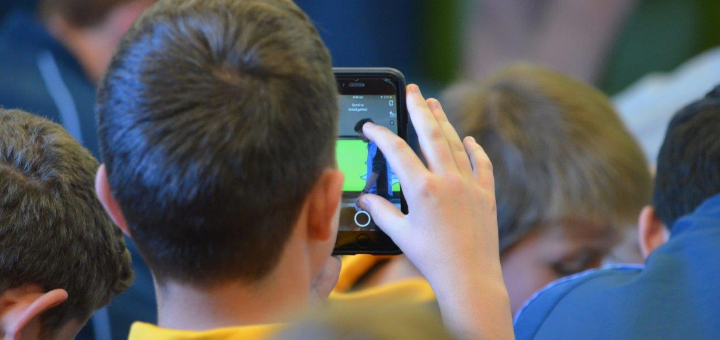
Many users of the internet have been stopped by the security check that asks visitors to "prove you are not a robot." You are generally asked to retype the letters that appear in a box below, select the pictures containing a tree, or solve a simple mathematical equation. The purpose is to distinguish between a human visiting the website and a robot utilizing sophisticated software to hack into websites and cause mayhem. Robots are unable to decipher the image or identify specific characters, thereby separating them from far superior humans who can easily decode the visual clues to solve 3 + 6. Humanity proved.
Perhaps this level of proof is suitable for a computer system trying to verify that which makes us human, but surely an ability to select pictures with trees is not the only line of division between humans and the world of machines? Julia Wake suggests that the proof of humanity runs at a much deeper level and explored this theme at the Remar Gold camp earlier this year. Like Saint Irenaeus the second-century theologian, Julia called her students to bring forth the glory of God by being fully alive and fully human. Youth ministry is a wonderful expression of the joy that resonates through our humanity; it reveals a vibrancy, a zeal and a desire to change the game of humanity. Whilst it remains beyond our technical capabilities to invent machines that recognize and understand human nature, we increasingly rely more heavily on their assistance for daily activities. The development of artificial intelligence, automation and robotics has progressed to the point that we now have autonomous vehicles, virtual eyes and hands free options for cars. It is no secret that computers are better than humans at tasks that require repetition, accuracy and detail. They have the ability to retrieve information in a split second and possess an unlimited amount of memory. “Just google it” has become a common phrase amongst my generation, who sit between the digital natives (under 30) and the digital immigrants (over 40). Is this reliance on technology a good thing? Laudato Si suggests that “we have the freedom needed to limit and direct technology; we can put it at the service of another type of progress, one which is healthier, more human, more social, more integral” (112). Technology is easily replaced, upgraded and quickly becomes obsolete. On the other hand, human evolution is a much slower progress and we must learn to live with both our achievements and limitations. There is a temptation in modern society to look down upon those who don’t possess the latest technology and companies actively encourage this type of discrimination by designing upgrades that are incompatible with older devices. There is a need to bridge the intergenerational gap between people also. It’s wonderful to see younger people teaching older people how to navigate the internet and make video calls, but the older generation also demonstrates how to live with challenges of a physical, emotional and spiritual nature. Writing about the Marist martyrs who were victims of the religious persecutions in Spain during the 1930s, Br Seán Sammon said, “in their human frailty, their choice was for Christ.” We too must acknowledge that our strength comes from God and not the latest software update. Bishop Vincent Long Van Nguyen, chairman of the Bishops Commission for Social Justice – Mission and Service recently launched the 2019 Social Justice Statement, "Making it Real: Genuine human encounter in our digital world." The opening letter by Most Reverend Terence J Brady said, “people of all generations hunger for friendship and genuine human encounter because we are made for community”. Whilst our appetite for community has not changed, it is interesting to note how people are now satisfying this hunger, particularly online. The XV Ordinary General Assembly of the Synod of Bishops in 2018 made the following observation, “young people tend to separate their behaviour into online and offline environments … Online relationships can become inhuman. Digital spaces blind us to the vulnerability of another human being and impede our self-reflection” (n.58). It is critical to understand that the virtual world offers a genuine reality for human encounter. Canadian poet Father Pier Giorgio Di Cicco writes, “we no longer access the Web. We are the Web” and ponders how people will experience the body of Christ if they do not know themselves as real people. He says, “the genius of casual encounters in the incarnate realm,” are the only thing that can keep people human, “as humanity is lost, so is Christ”. Can faith be found online and is this the new ardor and method of evangelization that Saint John Paul II imagined? “The essential question is whether the current information system is contributing to the betterment of the human person; that is, does it make people more spiritually mature, more aware of the dignity of their humanity, more responsible or more open to others, in particular to the neediest and the weakest” (Pontifical Council for Justice and Peace, 2004, n.415).
As I walked past the rows of campsites and caravans on my family holiday, I didn’t see people playing cards or talking with each other, they were all hunched over their devices, happily lost in a silent digital void. Despite their physical proximity, these families were completely disconnected from those closest to them. Are we being programmed by our technology to continually check notifications, attend to reminders and post social media updates? Sean Doran reminds us that “face time is always better than Facetime and it’s better to meet a friend than add one”. The pervasiveness of individualism, tuning out, earphones in and heads down is also creeping into our school communities. In stark contrast, Laudato Si and the 1977 document "The Catholic School" state that in order to promote human flourishing, there is a need for a shared belonging, interconnectedness and mutuality. Are school communities programming students to flourish in all their possibilities, or have college and university entrance tests become the highest priority for students, parents and teachers? In a results-obsessed society, are we teaching for deep learning and analysis; do our students spend enough time considering what it means to be fully alive] through art, philosophy, religion and development of their character? Our schools must call “for the fullest development of all that is human … Catholic educators can be certain that they make human beings more human” (18. Lay Catholics in Schools: Witnesses to Faith). Jesus offers the best example of the ultimate human, reprogramming people for love and restoring the code that was written into our DNA. He broadened the view of what it means to be fully alive, particularly for those He healed and transformed. Brother Giovanni Bigotto described the lives of the saints as living Beatitudes, “those great humanising factors: they are unassuming, people who thirst for justice, artisans of peace, men and women poor in spirit, neither self-centered nor overbearing, masters at being human. Frequently they are people who do a lot for others, especially those most in need; just think about Father Champagnat.” And just like these great examples, we too must work towards building a civilization of love so that we can understand what it means to be fully human (EFH, 2017). Do you feel fully alive, fully human? Are there some "lines of code" that need restoring? Are we programming young people to flourish in all their possibilities, or have college and university entrance tests become the highest priority for students, parents and teachers?
Copyright 2020 Nathan Ahearne
About the Author

Nathan Ahearne
Nathan Ahearne's faith journey has helped to shape the person he is today as husband, father, teacher and formator of young people. His vocation and faith are strengthened and nourished by those he encounters in service and contemplation. Nathan is a creative thinker and likes to roll up his sleeves and see projects through to completion. He is a John 10:10 fan. Read more at Expressions of Interest.


.png?width=1806&height=731&name=CatholicMom_hcfm_logo1_pos_871c_2728c%20(002).png)
Comments